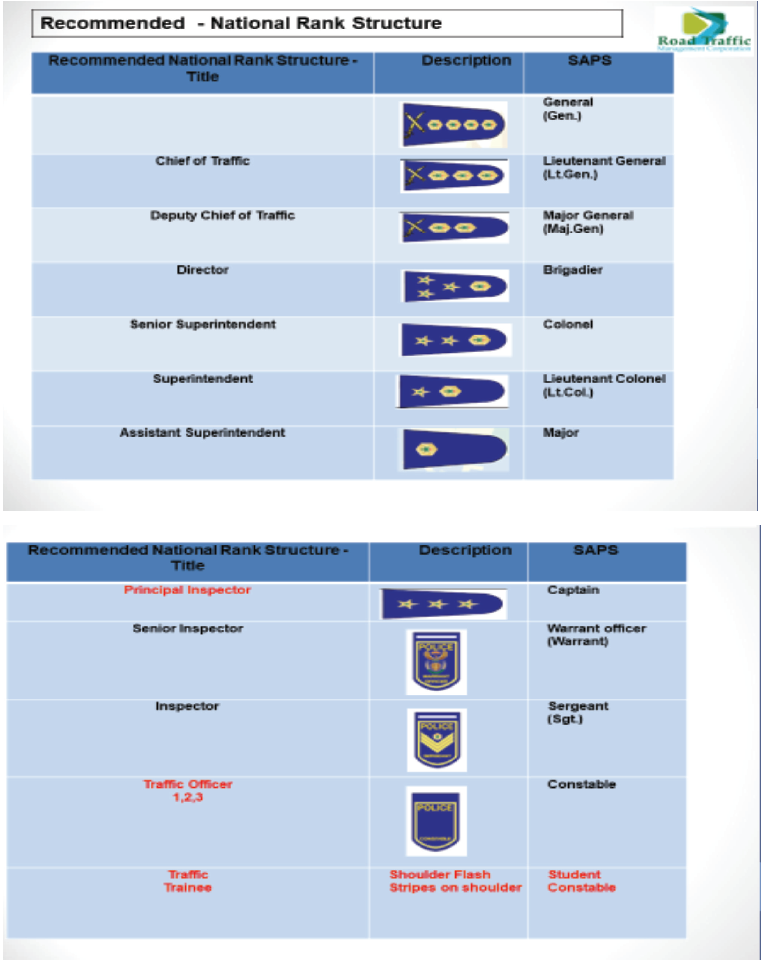Traffic policing is a profession that requires highly skilled practitioners. It is thus imperative that minimum entry requirements are established that will ensure that only high calibre persons are recruited, selected and appointed. The training of recruits is specified at two levels i.e. basic training requirements as well as secondary training levels for advancement within the traffic law enforcement fraternity.
Professionalism also dictates that traffic law enforcement practitioners are up-skilled by means of refresher programmes to meet the many challenges that they face during the execution of their duties, both at operational and management level. This Code prescribes the minimum standards of training and education for traffic law enforcement practitioners.
| 1.1 |
Recruitment, selection and appointment procedures |
| (a) |
Recruitment, hiring, retaining, evaluation, promotion, transfers and dismissal of employees, termination of employment, and disciplinary actions must be fair and in accordance with applicable legislation and policies. |
| (b) |
Recruitment may not overrule the provisions specifying the minimum qualifications and experience as set out in Part 2. |
| (c) |
Each traffic law enforcement authority must implement fair and transparent processes for the appointment and/or promotion of its staff as provided for in the Labour Relations Act, 1995 (Act No. 66 of 1995). |
| 1.2 |
Rationale and Significance of the Rank Insignia |
| (a) |
All law enforcement agencies since their inception have hierarchical command structures exemplified in different kinds of rank insignia and uniform as well as differently branded patrol vehicles. The rank insignia critically aligns the command structure and further promotes discipline as well as respect within the said structures. |
| (b) |
In this hierarchical structure, the ranking insignia denotes seniority between superiors and subordinates. This distinction between levels is critical because it facilitates the issuing of orders and instruction between superiors and subordinates without any hesitation at all material times. The ranking insignia therefore embeds the culture of compliance to all lower levels within the command formation and ensures prompt service delivery without glitches. |
| (c) |
The rank insignia denotes the office position of an individual in terms of command and control. In terms of road traffic law enforcement, the Chief of Traffic whose rank insignia is denoted by the most number of leaves as compared to that of his/her subordinates is the custodian of overall command of the traffic law enforcement operations. |
| (d) |
By virtue of his / her position, the Chief exercises command and control over the entire traffic law enforcement operations within the Province. This is extended to the subordinates under his / her command and control, to exercise the powers and authority assigned to them by virtue of their ranks. To illustrate the point, the Principal Provincial Inspector exercises supervisory functions over subordinates in the execution of their daily traffic law enforcement operations. |
| (e) |
A proper chain of command ensures that traffic law enforcement officers understand their responsibilities and that it be supervised appropriately. Only registered traffic officers / relevant law enforcement background are eligible for appointment either as a Chief Traffic Officer, Head of Traffic, Deputy Chief Traffic Officer, Deputy Head subject to the minimum requirements. |
| 1.3 |
The table below illustrates the recommended national rank structure. |

| 1.4 |
Chain of command and span of control |
| (a) |
The chain of command and span of management/control refer to:— |
| (i) |
Role and functions of a supervisor; |
| (ii) |
Communication of orders; |
| (v) |
By-passing the chain of command; |
| (vi) |
Lateral communication; |
| (vii) |
Number of subordinates that supervisors could effectively supervise; and |
| 1.4.1 |
Chain of command and span of control |
| (a) |
As a link in the chain of command, a senior officer with line authority has the right to direct the work of his/her immediate subordinates and to make certain decisions without consulting others. |
| (b) |
In the chain of command, every senior officer is also subject to the direction of his/her immediate superior. |
| (c) |
The purpose of the span of control principle in a traffic law enforcement authority is to allocate a certain number of traffic officers reporting directly to one senior officer, based on various organisational and management principles. |
| (d) |
The intrinsic value of an optimum chain of command and span of control shall be pursued to optimise service delivery and to ensure that professional traffic policing practices are implemented. |
| (e) |
These principles must be applied correctly to balance accountability, responsibility and the decision-making load across all levels of the authority. |
| (f) |
Chain of command and span of control bring clarity to the list of issues |
 Stamp Duties Act, 1968 (Act 77 of 1968)
Stamp Duties Act, 1968 (Act 77 of 1968)
